DiskBoss provides a large number of advanced file copy and data migration capabilities allowing one to copy vast amounts of files fast,
efficiently and reliably. DiskBoss allows one to copy files including access control lists (ACLs), security attributes, ownership information,
timestamps and file attributes. In addition, the user is provided with a large number of flexible file copy performance tuning and fault
tolerance options allowing one to copy data at various speeds, recover failed copy operations and minimize the potential impact on running production systems.
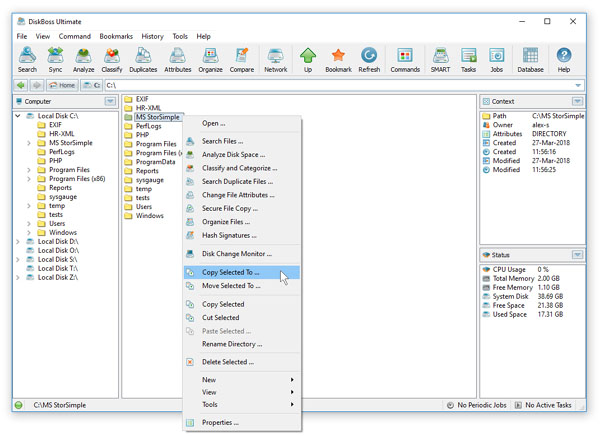
In order to start a simple file copy operation, select one or more files or directories in the DiskBoss file navigator, press the right mouse
button and select the 'Copy Files To' menu item. If you wish to perform a regular copy operation using default parameters, just press the 'Copy' button
and wait for the file copy operation to complete. During the file copy process, DiskBoss will display the copy progress dialog showing the total number
of copied files, the total amount of copied disk space and the file copy performance.
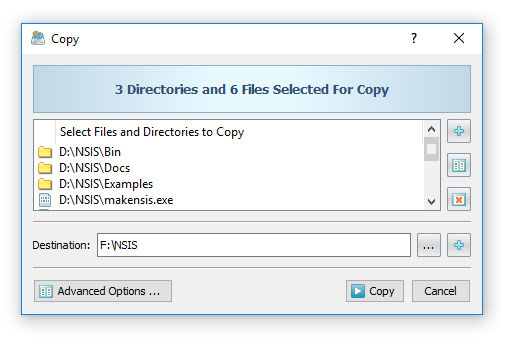
Copying vast amounts of data may require significant amounts of time. Sometimes, in order to perform an urgent operation, it may be required to temporary
pause a long-running data migration operation. Press the 'Pause' button to temporary suspend an ongoing file copy operation and then press the 'Continue' button
to resume the f operation. Press the 'Stop' button to cancel an ongoing file copy operation.
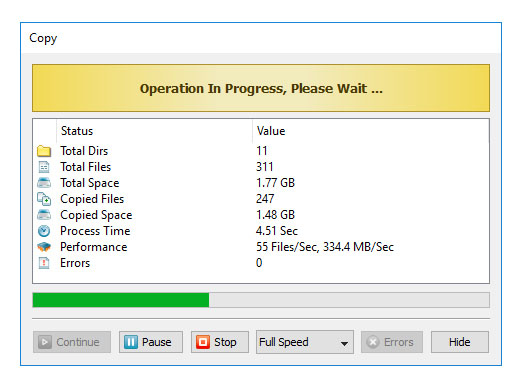
When copying files from/to protected operating system directories or running production systems, some copy operations may fail due to one or more files locked
by the operating system or other running applications. By default, DiskBoss logs non-critical errors in the operation log, which is accessible by pressing
the 'Errors' button, and continues the file copy operation. In addition, DiskBoss Professional and DiskBoss Ultimate provide the user with advanced
fault-tolerance and recovery options allowing one to retry failed copy operations after a designated period of time.
Pre-Configured File Copy Commands
Frequently used file copy and data migration operations may be pre-configured as user-defined commands, customized for user-specific needs and executed
in a single mouse click using the DiskBoss main GUI application. In addition, DiskBoss Ultimate and DiskBoss Server provide a command line utility allowing
one to execute user-defined file copy commands from batch files and shell scripts or schedule periodic file copy operations using a general purpose command scheduler.
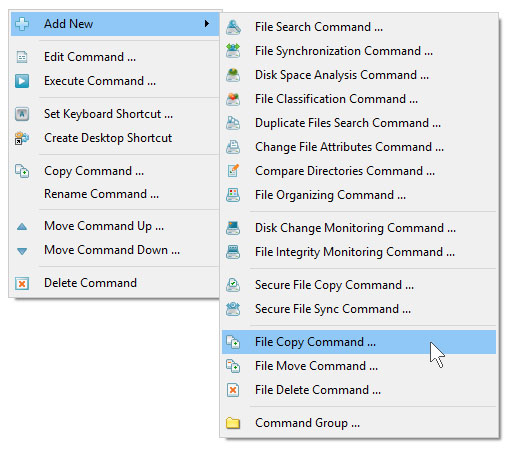
In order to pre-configure a user-defined file copy command, select the 'Commands' tool pane, press the right mouse button over the tool pane,
select the 'Add New - File Copy Command' menu item and specify a command name. On the file copy command dialog, select input files or directories
to be copied and specify one or more destination directories. Once finished configuring the file copy command, press the 'Save' button.
Now, the pre-configured file copy command will appear in the 'Commands' tool pane. In order to execute the pre-configured file copy command,
click on the command item in the 'Commands' tool pane.
Advanced File Copy Options
In order to open the advanced file copy options dialog, press the 'Advanced Options' button located on the file copy dialog.
The file options dialog consists of the 'General' tab, 'Advanced' tab, 'Rules' tab, 'Exclude' tab, 'Options' tab and 'Miscellaneous' tab.
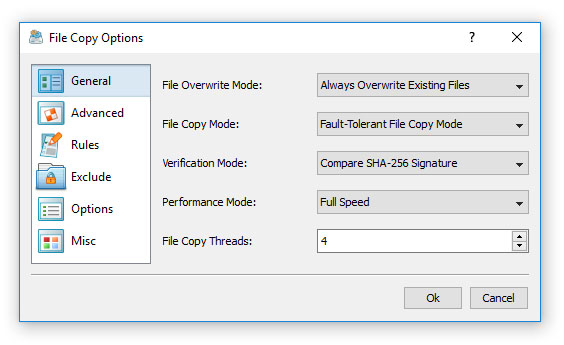
The 'General' tab provides the user with the ability to optimize file copy and data migration operations for user-specific storage
configurations and performance requirements. DiskBoss is optimized for multi-core/multi-CPU computers and advanced RAID storage systems
and capable of copying files using multiple, parallel file copy threads. During runtime, DiskBoss analyzes copied files and applies
different scheduling policies for different types of files thus maximizing the file copy performance and minimizing the copy time.
In order to speed up the file copy process, use multiple copy threads when copying files between multiple physical hard
disks or enterprise storage systems.
- File Overwrite Mode - DiskBoss provides four different file overwrite modes. By default, DiskBoss will overwrite all existing files. In addition, the user is provided with the ability to skip all existing files, overwrite existing files if the source file is newer or generate a unique file name for each existing destination file.
- File Copy Mode - The user is provided with four different file copy modes. In the 'Automatic' file copy mode, DiskBoss will automatically select an appropriate file copy mode depending on the file size, location and disk type. In the 'Regular' file copy mode, DiskBoss fill perform a simple, buffered file copy operation. In the 'Fault-Tolerant' file copy mode, DiskBoss will first copy the source file to the destination directory with a temporary file name and only after a successful file copy operation previously existed destination file will be overwritten. In the 'Operating System Native' file copy mode, DiskBoss will use the built-in file copy function provided by the operating system.
- Verification Mode - DiskBoss allows one to verify each file after completing the file copy operation. When the file copy verification option is enabled, DiskBoss will reread each copied file and verify that the destination file is identical to the source file. DiskBoss provides a number of file copy verifications modes including: MD5, SHA-1, SHA-256, BLAKE2-S, BLAKE2-B signatures and CRC-32/CRC-64 check sums.
- Performance Mode - Sometimes, it may be required to intentionally slow down a file copy operation in order to save resources and minimize the potential impact on running production applications. By default, DiskBoss copies files at the full speed, but the user is provided with the ability to copy files at 'Medium' and 'Low' speeds.
- File Copy Threads - DiskBoss is capable of performing multiple parallel file copy operations using multiple file copy threads. This can significantly increase the performance of file copy operations especially when copying large numbers of files between multiple disks, NAS storage devices or enterprise storage systems.
The 'Options' tab allows one to control the file copy progress bar, file attributes, timestamps, security descriptors, I/O buffering and file copy verification capabilities:
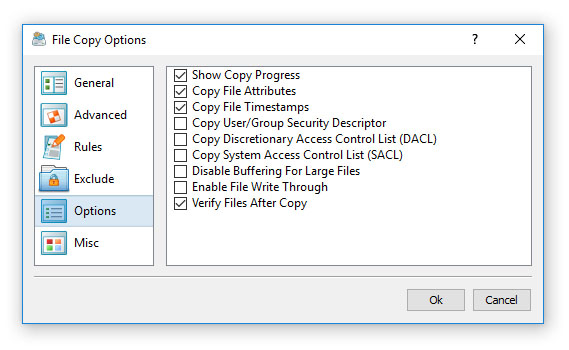
- Show Copy Progress - this option allows one to enable/disable the progress bar on the file copy process dialog. Disabling the progress bar when copying large amounts of files will result in better performance and significantly shorter copy times.
- Copy File Attributes - this option instructs DiskBoss to copy file attributes from source files to destination files. If this parameter is not set, all files will be created with default file attributes.
- Copy File Timestamps - this option instructs DiskBoss to copy the file creation, last modification and last access dates. If this parameter is not set, all time stamps will have the create and last modification date set to the date of the file copy operation.
- Copy User/Group Security Descriptor - this parameter instructs DiskBoss to copy the file ownership information from source files to destination files. This option requires the user to have the administrative privileges.
- Copy Discretionary Access Control List (DACL) - this parameter instructs DiskBoss to copy the discrete access control list (DACL) from source files to destination files. This option requires the user to have the administrative privileges.
- Copy System Access Control List (SACL) - this parameter instructs DiskBoss to copy the security control list (SACL) from source files to destination files. This option requires the user to have the administrative privileges.
- Disable Buffering For Large Files - this option allows one to copy files directly from the source file to the destination file without copying data to the operating system I/O buffers. This option should improve the performance of file copy operations when copying large files, but it is not supported on older operating systems such as Windows XP and Server 2003.
- Enable File Write Through - this option allows one to copy files using the RDMA protocol. This option should improve the performance of file copy operations when copying large files, but it is not supported on older operating systems such as Windows XP and Server 2003.
- Verify Files After Copy - this parameter instructs DiskBoss to verify each file after completing the file copy operation. When this parameter is set, DiskBoss will reread each copied file and verify that the destination file is identical to the source file. DiskBoss provides a number of file copy verification modes including: MD5, SHA-1, SHA-256, BLAKE2-S, BLAKE2-B signatures and CRC-32/CRC-64 check sums.
Copying Specific File Types or Categories
Sometimes, it may be required to copy specific types or categories of files according to one or more user-specific criteria.
For example, for backup purposes, the user may need to copy all types of image files that were modified during the last month.
DiskBoss Ultimate and DiskBoss Server provide the ability to configure one or more file matching rules allowing one to select
files by the file name, directory, file type, category, file size, file attributes, creation, last modification and last access
dates, user name, etc. During the file copy process, DiskBoss will evaluate all files using the specified file matching rules,
copy files matching the rules and skip all other files.
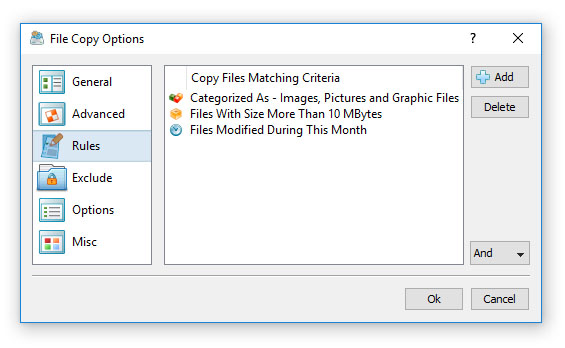
In order to add one or more file matching rules, open the file copy command dialog, press the 'Advanced Options' button, select
the 'Rules' tab and press the 'Add' button. Select an appropriate rule type and specify all the required parameters. The user is
provided with the ability to combine multiple different types of file matching rules allowing one to precisely select which files
to copy and which files to skip from the file copy process.
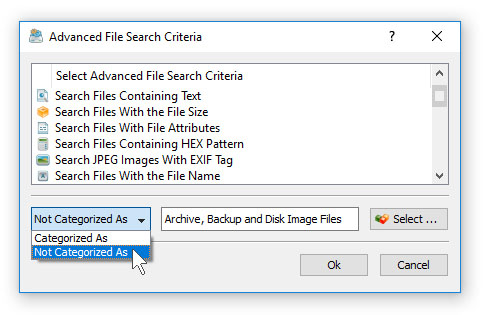
In addition to positive file matching rules allowing one to select which types of files to copy, the user is provided with negative
file matching rules capable of excluding specific types of files from the file copy process. For example, in order to exclude all
types of archive and backup files from the file copy process, add a file category rule, select the 'Archive and Backup Files' file
category and then select the negative 'Not Categorized' rule operator. In general, almost all types of file matching rules provide
positive and negative operators allowing one to easily construct sophisticated file matching rules capable of precisely select
which files to copy and which files to exclude from the file copy operation.
Controlling the Speed of File Copy Operations
When copying a large number of files, the file copy operation make take a very considerable amount of time. If the user needs to
quickly perform another operation, it may be very useful to temporary slow down the running file copy operation, perform the urgent
task and then resume the file copy operation at the full speed. DiskBoss provides the ability to dynamically change the speed of running file copy operations.
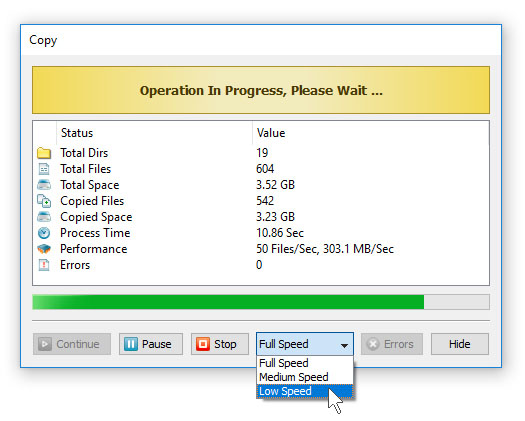
In order to change the speed of a running file copy operation, open the file copy process dialog, click on the 'Speed' combo
box and select an appropriate file copy performance mode. The 'Full Speed' mode uses all the available disk speed.
The 'Medium' speed mode tries to use approximately 50% of the available disk speed. The 'Low' speed mode tries
to use approximately 20% of the available disk speed.
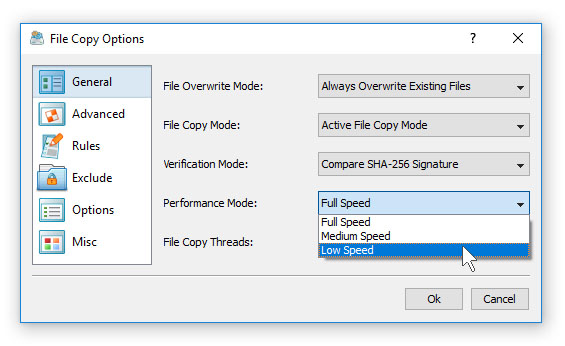
When files should be copied to/from a running production system, it may be necessary to pre-configure a file copy command to intentionally
slow down all file copy operations. In order to set the default performance mode for a pre-configured file copy operation, open the file
copy command dialog, press the 'Advanced Options' button, select the 'Advanced' tab and select an appropriate file copy performance mode.
Excluding Subdirectories from the File Copy Process
Sometimes, it may be required to exclude one or more subdirectories from the file copy process. For example, if you need to copy all
files from a disk excluding one or two special directories, you may specify the whole disk as an input directory and add the directories
that should be skipped to the exclude list.
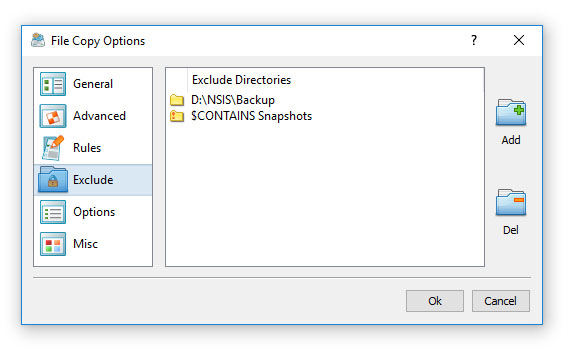
In order to add one or more directories to the exclude list, open the file copy command dialog, press the 'Advanced Options' button,
select the 'Exclude' tab and press the 'Add' button. All files and subdirectories located in the specified exclude directory will be
excluded from the file copy process. In addition, advanced users are provided with a number of exclude directories macro commands
allowing one to exclude multiple directories using a single macro command.
DiskBoss provides the following exclude directories macro commands:
- $BEGINS <Text String> - this macro command excludes all directories beginning with the specified text string.
- $CONTAINS <Text String> - this macro command excludes all directories containing the specified text string.
- $ENDS <Text String> - this macro command excludes all directories ending with the specified text string.
- $REGEX <Regular Expression> - this macro command excludes directories matching the specified regular expression.
- $DIRLIST <File Name> - this macro command excludes all directories listed in the user-specified text file.
- $FILELIST <File Name> - this macro command excludes all files listed in the user-specified text file.
For example, the exclude macro command '$CONTAINS Temporary Files' will exclude all directories with 'Temporary Files' in the full
directory path and the exclude macro command '$REGEX \.(TMP|TEMP)$' will exclude directories ending with '.TMP' or '.TEMP'.
Copying Files to Multiple Destination Directories
DiskBoss provides the ability to copy files to a number of destination disks, directories or network shares allowing one to easily
distribute files to a large number of servers or virtual machines through the network. In the simplest case, open the file copy
command dialog and press the 'Add' button located on the right side of the destination directory entry.
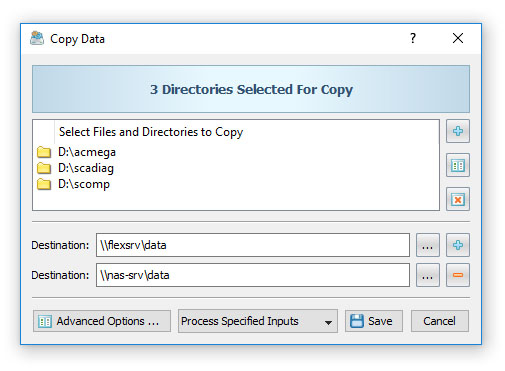
DiskBoss will create an additional entry allowing one to specify a second destination directory. Press the 'Add Destination Directory' button
again and DiskBoss will create one more destination directory entry. Press the 'Delete' button located on the right size of a destination
directory entry, to remove the destination directory.
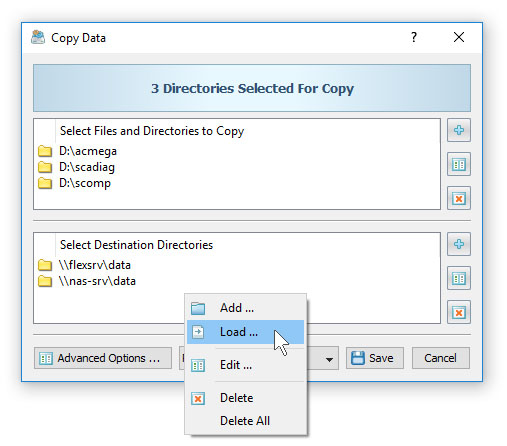
If the user needs to distribute files to tens or hundreds of servers or virtual machines, it may be more effective to load a list of destination
directories from a text file. In order to load destination directories from a text file, press the 'Add Destination Directory' button three times
until the individual directory entries will be replaced with a list of destination directories, press the right mouse button over the list of
destination directories, select the 'Load' menu item and specify the name of the text file to load destination directories from. The text file
should include a list of destination directories in the plain text format with one directory per line.
Schedule Periodic File Copy Operations
In addition to the ability to perform manual file copy operations using the DiskBoss GUI application, the user is provided with a server-based
product version, named DiskBoss Server, which runs in the background as a service and allows one to schedule periodic file copy operations. First of all,
start the DiskBoss Server client GUI application, press the 'Add' button located on the main toolbar and select the 'Add - File Copy Command' menu item.
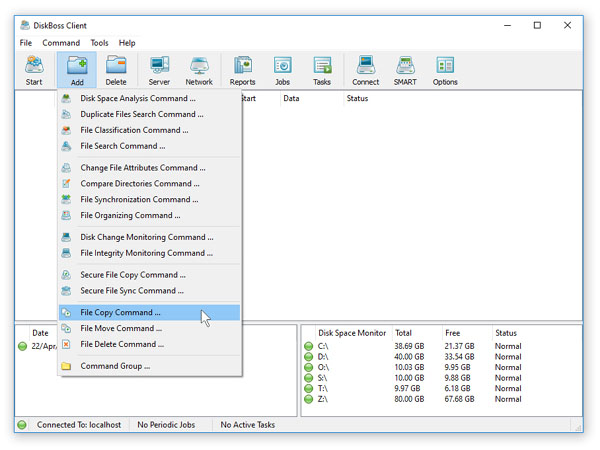
Enter a command name, specify a number of input files or directories that should be copied, specify one or more destination directories and press the 'Save' button.
Now, press the 'Jobs' button located on the main toolbar and press the 'Add' button to add a new periodic job. The periodic job dialog allows one to define
one or more periodic schedules and one or more pre-configured analysis or file management commands to execute.
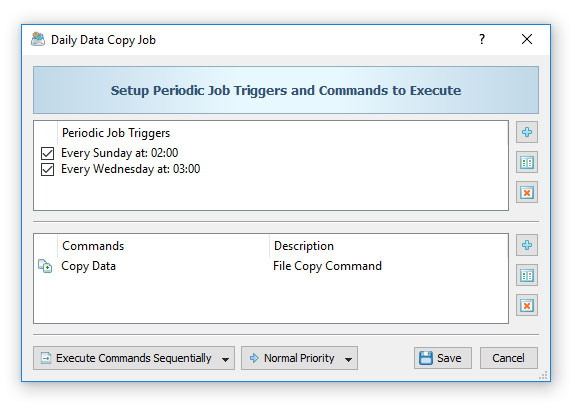
Press the 'Add' button located on the right side of the top view to add a periodic job trigger. The user is provided with a number of hourly,
daily and weekly periodic scheduling options allowing one to easily define the desired schedule. Once finished configuring periodic job triggers,
press the 'Add Command' button located on the right side of the bottom view to add one or more pre-configured DiskBoss commands to be executed
according to the specified schedule. DiskBoss allows one to execute multiple file copy commands in each periodic job and provides the ability
to specify how to execute these commands: sequentially or in parallel.
Monitor Disk Changes and Copy Files in Real-Time
DiskBoss Server provides the ability to monitor a disk or directory and automatically copy newly created files to one or more destination directories.
The user can just drag-and-drop files into the monitored directory and all files will be automatically copied to the required destination directories.
In order to setup a disk change monitoring command, open the DiskBoss Server client GUI application, press the 'Add' button located on the main toolbar
and select the 'Disk Change Monitoring Command' menu item.
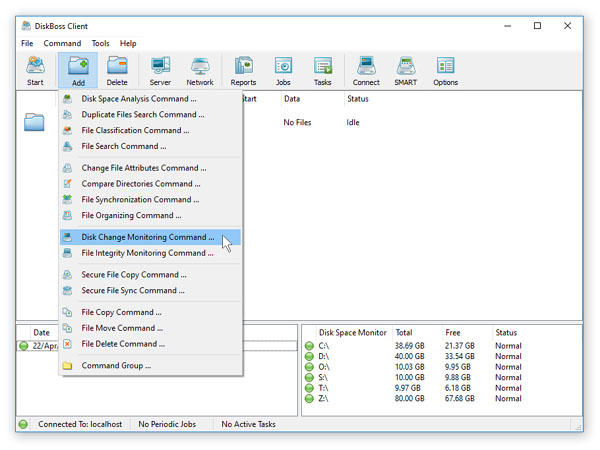
Enter a command name and specify a disk or directory to monitor. On the disk monitor options dialog, select the 'Actions' tab, enable disk monitoring actions
and specify the number of disk changes to trigger the actions. Now, enable the 'Execute DiskBoss Command' action and select the pre-configured file copy command
to be executed when the user-specified number of disk changes are detected.
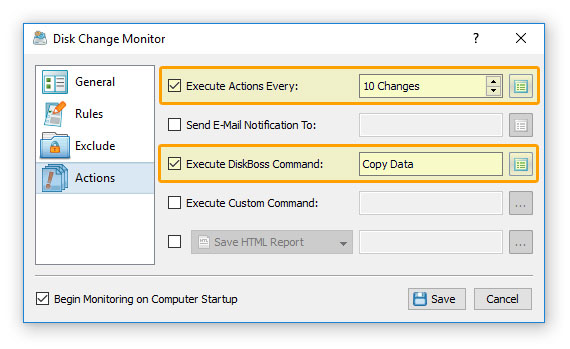
Once finished configuring the disk change monitoring command, select the command in the commands view, press the right mouse button and select the 'Start Command' menu item.
DiskBoss Server will monitor changes in the specified disk and execute the selected file copy command. The DiskBoss client GUI application may be closed
and the DiskBoss service will continue to run in the background, monitor the specified disk or directory and execute the selected file copy command fully automatically.
Copying Files Using the DiskBoss Command Line Utility
In addition to the DiskBoss GUI application, DiskBoss Ultimate and DiskBoss Server provide a command line utility allowing one to perform
file copy operations from batch files and shell scripts. The DiskBoss command line utility is located in the '<ProductDir>/bin' directory.
Command Line Syntax:
diskboss -copy –dir <Source 1> [ ... Source X ] –dest <Destination> [ Options ]
diskboss -move –dir <Source 1> [ ... Source X ] –dest <Destination> [ Options ]
diskboss -execute <Pre-Configured File Copy Command>
Parameters:
–dir <Source> -dest <Destination Directory>
At least one source file or directory and a destination directory should be specified. In order to ensure proper parsing of command line arguments,
directories and file names containing space characters should be double quoted.
Options:
-verify
This parameter instructs DiskBoss to verify each file after copy.
-streams <StreamCount>
This parameter specifies the number of simultaneous file copy streams.
-file_scanner <sequential or parallel>
This parameter specifies the file scanning mode: sequential or parallel.
Use the parallel scanning mode when copying multiple input directories located on a RAID array or multiple disk drives.
-file_delay <delay in milliseconds>
This parameter instructs the DiskBoss' copy engine to insert a delay of X ms. after each copied file.
Use this option when you need to slowly copy data to or from a busy production system in order to minimize the potential performance degradation.
-block_delay <delay in milliseconds>
This parameter instructs the DiskBoss' copy engine to insert a delay of X ms.
after each data block. Use this option when you need to slowly copy data to or
from a busy production system in order to minimize the potential performance degradation.
-retry_count <RetryCount>
This parameter instructs the DiskBoss' copy engine to retry failed copy operations.
Use this option when copying data over an unreliable network connection or when some source files may be locked during the copy operation.
-retry_delay <retry delay in seconds>
This parameter specifies the time delay between copy retry operations.
-max_pending_task <MaxPendingTask>
This parameter specifies the maximum number of pending retry operations.
-overwrite_mode <OverwriteMode>
This parameter specifies the file overwrite mode: overwrite, overwrite_if_newer or skip.
-copy_dacl
This parameter instructs to copy files' access control lists (DACL).
-copy_sacl
This parameter instructs to copy files' security control lists (SACL).
-copy_owner
This parameter instructs to copy files' user/group information.
-copy_time
This parameter instructs to copy files' last access/write/creation times.
-copy_attr
This parameter instructs to copy files' read-only/system/hidden attributes.
-copy_all
This parameter instructs to copy files' ACL, ownership, times and attributes.
-v
This command shows the product’s major version, minor version, revision and build date.
-help
This command shows the command line usage information.

